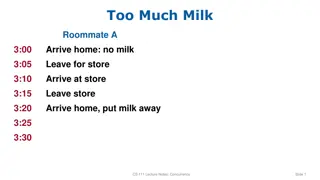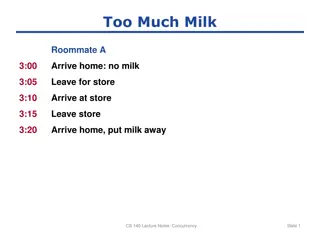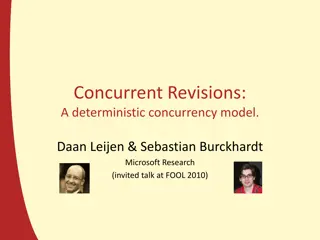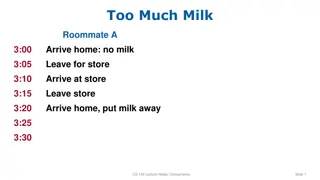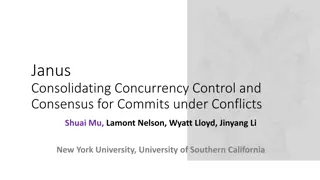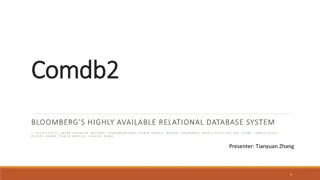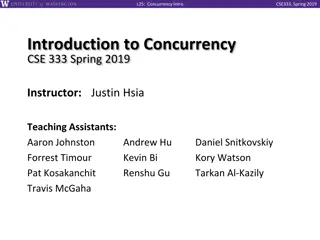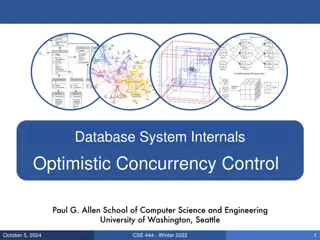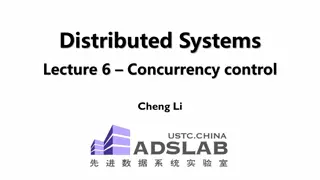
Granularity Levels and Transaction Consistency in Databases
Explore the importance of lock granularity and consistency levels in transactions, along with the ACID properties, transaction examples, challenges faced, and concurrency issues in database systems. Learn about transaction scheduling, isolation levels, and more to ensure data integrity and system efficiency.
Uploaded on | 1 Views
Download Presentation

Please find below an Image/Link to download the presentation.
The content on the website is provided AS IS for your information and personal use only. It may not be sold, licensed, or shared on other websites without obtaining consent from the author. If you encounter any issues during the download, it is possible that the publisher has removed the file from their server.
You are allowed to download the files provided on this website for personal or commercial use, subject to the condition that they are used lawfully. All files are the property of their respective owners.
The content on the website is provided AS IS for your information and personal use only. It may not be sold, licensed, or shared on other websites without obtaining consent from the author.
E N D
Presentation Transcript
Lock Granularity and Consistency Levels (Lecture 7, cs262a) Ali Ghodsi and Ion Stoica, UC Berkeley February 7, 2018
Papers Granularity of Locks and Degrees of Consistency in a Shared Database, J. N. Gray, R. A. Lorie, G. R. Putzolu, I. L. Traiger Generalized Isolation Level Definitions, A. Adya, B. Liskov, and P. O'Neil
The ACID properties of Transactions Atomicity:all actions in the transaction happen, or none happen Consistency:if each transaction is consistent, and the database starts consistent, it ends up consistent, e.g., Balance cannot be negative Cannot reschedule meeting on February 30 Isolation:execution of one transaction is isolated from others Durability:if a transaction commits, its effects persist
Example: Transaction 101 BEGIN; --BEGIN TRANSACTION UPDATE accounts SET balance = balance - 100.00 WHERE name = 'Alice'; UPDATE branches SET balance = balance - 100.00 WHERE name = (SELECT branch_name FROM accounts WHERE name = 'Alice'); UPDATE accounts SET balance = balance + 100.00 WHERE name = 'Bob'; UPDATE branches SET balance = balance + 100.00 WHERE name = (SELECT branch_name FROM accounts WHERE name = 'Bob'); COMMIT; --COMMIT WORK Transfer $100 from Alice s account to Bob s account
Why is it Hard? Failures: might leave state inconsistent or cause updates to be lost Remember last lecture? Concurrency: might leave state inconsistent or cause updates to be lost This lecture and the next one!
Concurrency When operations of concurrent threads are interleaved, the effect on shared state can be unexpected Well known issue in operating systems, thread programming Critical section in OSes Java use of synchronized keyword
Transaction Scheduling Why not run only one transaction at a time? Answer: low system utilization Two transactions cannot run simultaneously even if they access different data Goal of transaction scheduling: Maximize system utilization, i.e., concurrency Interleave operations from different transactions Preserve transaction semantics Logically all operations in a transaction are executed atomically Intermediate state of a transaction is not visible to other transactions
Anomalies with Interleaved Execution May violate transaction semantics, e.g., some data read by the transaction changes before committing Inconsistent database state, e.g., some updates are lost Anomalies always involves a write ; Why?
P0 Overwriting uncommitted data Write-write conflict T2 writes value modified by T1 before T1 commits, e.g, T2 overwrites W(A) before T1 commits T1:W(A), W(B) T2: W(A),W(B) Violates transaction serializability If transactions were serial, you d get either: T1 s updates of A and B T2 s updates of A and B
P1 Reading uncommitted data (dirty read) Write-read conflict (reading uncommitted data or dirty read) T2 reads value modified by T1 before T1 commits, e.g., T2 reads A before T1 modifies it T1:R(A),W(A), T2: R(A),
P3 Non-repeatable reads Read-Write conflict T2 reads value, after which T1 modifies it, e.g., T2 reads A, after which T1 modifies it T1: R(A),W(A) T2:R(A), R(A),W(A) Example: Mary and John want to buy a TV set on Amazon but there is only one left in stock (T1) John logs first, but waits (T2) Mary logs second and buys the TV set right away (T1) John decides to buy, but it is too late
Goals of Transaction Scheduling Maximize system utilization, i.e., concurrency Interleave operations from different transactions Preserve transaction semantics Semantically equivalent to a serial schedule, i.e., one transaction runs at a time T2: T2: R, W, R, R, W T1: T1: R, W, R, W Serial schedule (T1, then T2): Serial schedule (T2, then T1): R, W, R, W, R, W, R, R, W R, W, R, R, W, R, W, R, W
Two Key Questions 1) Is a given schedule equivalent to a serial execution of transactions? R, R, W, W, R, R, R, W, W Schedule: ? ? Serial schedule (T1, then T2): Serial schedule (T2, then T1): R, W, R, W, R, W, R, R, W : R, W, R, R, W, R, W, R, W 2) How do you come up with a schedule equivalent to a serial schedule?
Transaction Scheduling Serial schedule: : A schedule that does not interleave the operations of different transactions Transactions run serially (one at a time) Equivalent schedules: For any storage/database state, the effect (on storage/database) and output of executing the first schedule is identical to the effect of executing the second schedule Serializable schedule: A schedule that is equivalent to some serial execution of the transactions Intuitively: with a serializable schedule you only see things that could happen in situations where you were running transactions one-at-a-time
Conflict Serializable Schedules Two operations conflict if they Belong to different transactions Are on the same data At least one of them is a write Two schedules are conflict equivalent iff: Involve same operations of same transactions Every pair of conflicting operations is ordered the same way Schedule S is conflict serializable if S is conflict equivalent to some serial schedule
Conflict Equivalence Intuition If you can transform an interleaved schedule by swapping consecutive non-conflicting operations of different transactions into a serial schedule, then the original schedule is conflict conflict serializable serializable, e.g., T1:R(A),W(A), R(B),W(B) T2: R(A),W(A), R(B),W(B) T1:R(A),W(A), R(B), W(B) T2: R(A), W(A), R(B),W(B) T1:R(A),W(A),R(B), W(B) T2: R(A),W(A), R(B),W(B)
Conflict Equivalence Intuition If you can transform an interleaved schedule by swapping consecutive non-conflicting operations of different transactions into a serial schedule, then the original schedule is conflict conflict serializable serializable, e.g., T1:R(A),W(A),R(B), W(B) T2: R(A),W(A), R(B),W(B) T1:R(A),W(A),R(B), W(B) T2: R(A), W(A),R(B),W(B) T1:R(A),W(A),R(B),W(B) T2: R(A), W(A),R(B),W(B)
Conflict Equivalence Intuition If you can transform an interleaved schedule by swapping consecutive non-conflicting operations of different transactions into a serial schedule, then the original schedule is conflict conflict serializable serializable, e.g., T1:R(A), W(A) T2: R(A),W(A), Is this schedule serializable?
Dependency Graph Dependency graph: Dependency graph: Transactions represented as nodes Edge from Ti to Tj: an operation of Ti conflicts with an operation of Tj Ti appears earlier than Tj in the schedule Theorem: Theorem: Schedule is conflict serializable if and only if its dependency graph is acyclic
Example Conflict serializable schedule: T1:R(A),W(A), R(B),W(B) T2: R(A),W(A), R(B),W(B) B A Dependency graph T1 T2 No cycle!
Example Conflict that is not serializable: T1:R(A),W(A), R(B),W(B) T2: R(A),W(A),R(B),W(B) A Dependency graph T1 T2 B Cycle: The output of T1 depends on T2, and vice-versa
Notes on Conflict Serializability Conflict Serializability doesn t allow all schedules that you would consider correct This is because it is strictly syntactic - it doesn t consider the meanings of the operations or the data Many times, Conflict Serializability is what gets used, because it can be done efficiently See isolation degrees/levels next Two-phase locking (2PL) is how we implement it
Srializability Conflict Serializability Following schedule is not not conflict serializable Dependency graph A A A T1:R(A), W(A), T2: W(A), T3: WA However, the schedule is serializable since its output is equivalent with the following serial schedule T1:R(A),W(A), T2: W(A), T3: WA T1 T2 A T3 Note: deciding whether a schedule is serializable (not conflict- serializable) is NP-complete
Locks Locks to control access to data Two types of locks: shared (S) lock: multiple concurrent transactions allowed to operate on data exclusive (X) lock: only one transaction can operate on data at a time Lock Compatibility Matrix Held\Request S S X X Block Block Yes Block
Two-Phase Locking (2PL) 1) Each transaction must obtain: S (shared) or X (exclusive) lock on data before reading, X (exclusive) lock on data before writing 2) A transaction can not request additional locks once it releases any locks Thus, each transaction has a growing phase followed by a shrinking phase 4 # Locks Held Lock Point! Growing Phase Shrinking Phase 3 2 1 0 1 3 5 7 9 11 13 15 17 19 Time
Two-Phase Locking (2PL) 2PL guarantees conflict serializability Doesn t allow dependency cycles. Why? Answer: a dependency cycle leads to deadlock Assume there is a cycle between Ti and Tj Edge from Ti to Tj: Ti acquires lock first and Tj needs to wait Edge from Tj to Ti: Tj acquires lock first and Ti needs to wait Thus, both Ti and Tj wait for each other Since with 2PL neither Ti nor Tj release locks before acquiring all locks they need deadlock Schedule of conflicting transactions is conflict equivalent to a serial schedule ordered by lock point
Example T1 transfers $50 from account A to account B T1:Read(A),A:=A-50,Write(A),Read(B),B:=B+50,Write(B) T2 outputs the total of accounts A and B T2:Read(A),Read(B),PRINT(A+B) Initially, A = $1000 and B = $2000 What are the possible output values?
Is this a 2PL Schedule? 1 2 3 4 Lock_X(A) <granted> Read(A) A: = A-50 Write(A) Lock_S(A) 5 6 7 8 9 Unlock(A) <granted> Read(A) Unlock(A) Lock_S(B) <granted> Lock_X(B) 10 11 12 13 14 15 16 Read(B) Unlock(B) PRINT(A+B) <granted> Read(B) B := B +50 Write(B) Unlock(B) No, and it is not serializable
Is this a 2PL Schedule? 1 2 3 4 Lock_X(A) <granted> Read(A) A: = A-50 Write(A) Lock_S(A) 5 6 7 8 9 Lock_X(B) <granted> Unlock(A) <granted> Read(A) Lock_S(B) Read(B) B := B +50 Write(B) Unlock(B) 10 11 12 13 14 15 16 <granted> Unlock(A) Read(B) Unlock(B) PRINT(A+B) Yes, it is serializable
Strict 2PL (contd) All locks held by a transaction are released only when the transaction completes In effect, shrinking phase is delayed until: a) Transaction has committed (commit log record on disk), or b) Decision has been made to abort the transaction (then locks can be released after rollback).
Is this a Strict 2PL schedule? 1 2 3 4 Lock_X(A) <granted> Read(A) A: = A-50 Write(A) Lock_S(A) 5 6 7 8 9 Lock_X(B) <granted> Unlock(A) <granted> Read(A) Lock_S(B) Read(B) B := B +50 Write(B) Unlock(B) 10 11 12 13 14 15 16 <granted> Unlock(A) Read(B) Unlock(B) PRINT(A+B) No: Cascading Abort Possible
Granularity What is a data item (on which a lock is obtained)? Most times, in most modern systems: item is one tuple in a table Sometimes (especially in early 1970s): item is a page (with several tuples) Sometimes: item is a whole table
Granularity trade-offs Larger granularity: fewer locks held, so less overhead; but less concurrency possible false conflicts when txns deal with different parts of the same item Smaller fine granularity: more locks held, so more overhead; but more concurrency is possible System usually gets fine grain locks until there are too many of them; then it replaces them with larger granularity locks
Multigranular locking Care needed to manage conflicts properly among items of varying granularity Note: conflicts only detectable among locks on a given item name System gets intention mode locks on larger granules before getting actual S/X locks on smaller granules Conflict rules arranged so that activities that do not commute must get conflicting locks on some item
Lock Mode Conflicts Held\Request IS IS IX S SIX X IX Yes Yes Block Block Block S Yes Block Yes Block Block SIX Yes Block Block Block Block X Block Block Block Block Block Yes Yes Yes Yes Block
Problems with serializability The performance reduction from isolation is high Transactions are often blocked because they want to read data that another transactions has changed For many applications, the accuracy of the data they read is not crucial e.g. overbooking a plane is ok in practice e.g. your banking decisions would not be very different if you saw yesterday s balance instead of the most up-to-date
Explicit isolation levels A transaction can be declared to have isolation properties that are less stringent than serializability However SQL standard says that default should be serializable (Gray 75 called this level 3 isolation ) In practice, most systems have weaker default level, and most transactions run at weaker levels! Isolation levels are defined with respect to data access conflicts (phenomena) they preclude
Phenomena P0: T2 writes value modified by T1 before T1 commits Transactions cannot be serialized by their writes P1 Dirty Read: T2 reads value modified by T1 before T1 commits If T1 aborts it will be as if transaction T2 read values that have never existed P2 Non-Repeatable Read: T2 reads value, after which T1 modifies it If T2 attempts to re-read value it can read another value P3 Phantom: (see next)
Phantom 1. A transaction T1 reads a set of rows that satisfy some condition 2. Another transaction T2 executes a statement that causes new rows to be added or removed from the search condition 3. If T1 repeats the read it will obtain a different set of rows.
Phantom Example T1 Select count(*) where dept = Acct // find and S-lock ( Sue , Acct , 3500) and ( Tim , Acct, 2400) T2 Insert ( Joe , Acct , 2000) // X-lock the new record Commit // release locks Select sum(salary) where dept = Acct // find and S-lock ( Sue , Acct , 3500) and ( Tim , Acct, 2400) and ( Joe , Acct , 2000)
Isolation Levels Isolation levels Degree Proscribed Proscribed Phenomena Phenomena Read locks on Read locks on data items and phantoms items and phantoms (same unless noted) (same unless noted) none none Short read locks Long data-item read locks, short phantom locks Long read locks data Write Write locks on data locks on data items and phantoms items and phantoms (always the same) (always the same) Short write locks Long write locks Long write locks Long write locks 0 1 2 none P0 P0, P1 P0, P1, P2 READ UNCOMMITTED READ COMITTED REAPEATABLE READ SERIALIZABLE 3 P0, P1, P2, P3 Long write locks Gray s isolation degrees ANSI
Direct Serialization Graph (DSG) Conflict Name Directly write-depends Directly read-depends Directly anti-depends Description T1 writes value, then T2 overwrites it T1 writes value, then T2 reads it T1 reads value, then T2 writes it DSG T1 T2 T1 T2 T1 T2 ww wr rw Example: T1:W(A), W(B), W(C) T2: T3: W(B) R(B), W(C) R(C), W(B) wr rw wr T1 T2 T3 ww ww
Disallowing P0 Writes by T1 are not overwritten by T2 while T1 is uncommitted Simplifies recovery from aborts, e.g., T1 updates x, T2 overwrites x , and then T1 aborts The system must not restore x to T1 s pre-state However, if T2 aborts later, x must be restored to T1 s pre-state! Serializes transactions based on their writes alone all writes of T2 must be ordered before or after all writes of T1 G0 just disallows this one
G0 G0: DSG contains a directed cycle consisting entirely of write- dependency edges Just ensure serialization on writes alone More permissive than Degree 1 as allows concurrent transactions to modify same object Example: T1:W(A) W(B), T2: W(A), W(B), ww T1 T2 ww
Disallowing P1 Writes of T1 could not be read by T2 while T1 is still uncommitted It prevents a transaction T2 from committing if T2 has read the updates of a transaction that might later abort It prevents transactions from reading intermediate modifications of other transactions It serializes committed transactions based on their read/write- dependencies (but not their antidependencies), i.e., If transaction T2 depends on T1, T1 cannot depend on T2
G1 G1a Aborted reads: T2 has read a value written by an aborted transaction T1 G1b Intermediate Reads: Committed transaction T2 has read an intermediate value written by transaction T1 G1c Circular Information Flow: DSG contains a directed cycle consisting entirely of dependency edges Disallowing G1c ensures that if transaction T2 is affected by transaction T1, T2 does not affect T1
Disallowing P2 T1 cannot modify value read by T2 Precludes a transaction reading inconsistent data and making inconsistent updates
G2 Just prevent transactions that perform inconsistent reads or writes from committing G2 Anti-dependency Cycles: DSG contains a directed cycle with one or more anti-dependency edges G2-item Item Anti-dependency Cycles: DSG contains a directed cycle having one or more item-antidependency edges
Generalized Isolation Levels Isolation levels READ UNCOMMITTED READ COMITTED REAPEATABLE READ SERIALIZABLE G0 G0 NA Not possible Not possible Not possible G1 G1 NA Possible Not possible Not possible G2 G2- -Item Item NA Possible Not possible Not possible G2 G2 NA Possible Possible Not possible




